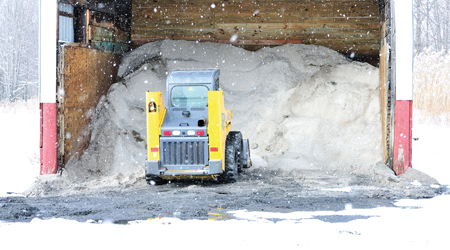
Best practice guidelines for sustainable salt use in winter management operations includes three primary categories: Purchasing, Storage and Transport, and Operations. Consider using these three categories as a guideline to help organize and optimize a winter management budget, planning and implementation processes.
When planning for salt use, depending on your job role and type of organization you are managing, there are likely financial outlays and profitability responsibilities to consider. Balancing these responsibilities with the environmental stewardship should also be a major consideration.
For example, there are several research studies confirming that chloride contamination of fresh water bodies (lakes, reservoirs, rivers, streams and groundwater) from salt used in winter management operations is on the rise. And several regions in North America have confirmed that more than half of all contamination originates from private parking lots and poor storage practices by private property owners and contractors.
Purchasing Inventory
A policy for projecting how much salt to purchase should always be based on the total estimated square footage or acres of the service area, averaged with a minimum of five years of weather history — and salt use history, if available.
Furthermore, a purchasing policy should include the establishment of purchase agreements with multiple suppliers. This optimizes control of supply and quality, and mitigates risk due to fluctuations in supply availability and cost.
When considering the amount of de-icing materials to purchase, inventory should include the most efficient products to apply/blend for use in markets that experience pavement temperatures below 15 degrees Fahrenheit — the temperature at which sodium chloride is no longer effective.
Pre-season ordering is a preferred option for facility cleaning managers. This will insure the best price and availability of inventory. In fact, it is recommended that departments purchase a minimum of 50 to 75 percent of their estimated de-icing material (solids and brines) inventory by the end of summer.
Storage Tips
Once the investment has been made for ice melt, it’s important that departments protect that investment by properly storing and transporting those products. When it comes to salt inventory management, best practices include having a minimum of five ‘normal’ or average events-worth of material (solid salt and/or brines) inventory on-hand during the season.
Between storms and in the off seasons, salt should be stored on an impervious surface and covered in a manner that avoids run-off or water entering the storage area. It’s best to store salt in a dedicated spot that features self-contained bins (i.e. has a floor and cover) or storage containers. Of course, no matter the storage options, be sure to verify it meets all local, state/provincial and federal requirements.
It is also recommended to include a weekly monitoring process for stored salt inventories. These checks will guarantee quality control (integrity of storage, leaching, etc.), and post-storm monitoring for inventory management.
When transporting ice melt, staff should be trained to make sure bulk material is well covered. One option includes using tarps or covers that are now typically included as an option with the purchase of many new salt spreaders. If utilizing large truck loads of bulk salt, train staff to cover the salt with a heavy duty tarp. And if staff is required to transport salt via highways, they will need to comply with all local and state/provincial regulations for securing and covering the loads.
Tips To Applying Ice Melt

 The Down and Dirty on Cleaning in Virus Season
The Down and Dirty on Cleaning in Virus Season How Surfactant Use is Expanding in Commercial Cleaning
How Surfactant Use is Expanding in Commercial Cleaning Operational Excellence Series 2025: Better Budgeting
Operational Excellence Series 2025: Better Budgeting